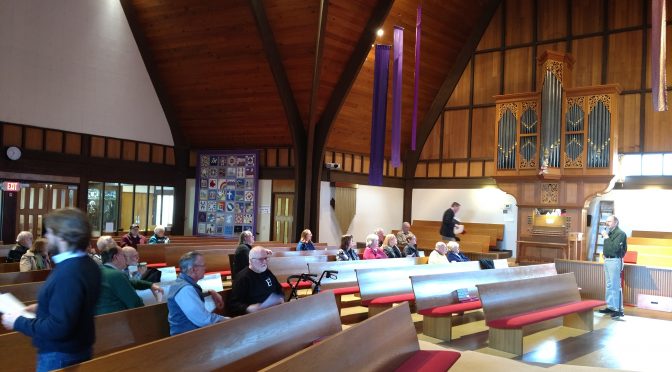It was Old Home Week at Shelton United Methodist Church as AGO members from the Tacoma, Seattle, and Olympia chapters gathered to begin their day of organ exploration in Shelton. Fritts Opus 1 is there, and Tacoma AGO member Paul Fritts was present to discuss his first mechanical action organ. Tacoma AGO member Paul Thornock grew up as a member of Shelton United Methodist and met Paul Fritts when the organ was being serviced a few years after installation. Fourteen years old at the time, Paul Thornock began studying organ, continued those studies through college and graduate schools, and was on hand to demonstrate “his first organ.” That church has produced a number of other organists, including Doug Cleveland, who is a member of the Seattle AGO chapter, and who served as Shelton UMC organist when he was in high school.
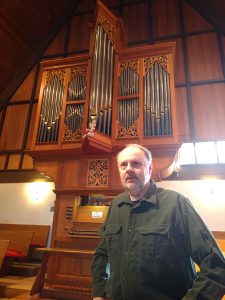
In 1979, Shelton UMC was using a beloved Hammond “organ”, and many saw little reason for a change. The town had a population of only about 7,000 but with a disproportionate number of scientists and visionaries due to the presence of a research institution. Many attended Shelton UMC, and several ended up on the organ committee. Paul Fritts was in his twenties and knew that he wanted to build tracker organs. He had spent a few weeks in Holland, learning voicing and pipe making, but had not been to the rest of Europe. He knew that he wanted to produce a sound like the “antique” organs of Europe but had not actually heard that sound.
With help from family, associate Ralph Richards, and pipe makers in Holland, Paul produced Opus 1, a 2-manual, 16-stop organ with suspended mechanical key action, mechanical stop action, and a flat pedal board. Paul is clearly proud of his first organ and with good reason. It has a bold sound that fills the room, thanks to a combination of good acoustics, narrow-scaled principal pipes in the Dutch tradition, and a higher wind pressure than would be found in his current organs. The practice of using higher wind pressure with more closed voicing parameters at the mouth has been described as a “vocal” sound. Many builders at the time, following John Brombaugh’s lead, took this approach. Paul Fritts’ current organs use dramatically lower wind pressure, with more open voicing parameters, a practice known as an “instrumental” sound. The pipe shades, an essential component in blending and focusing organ sound, were designed and carved by Paul’s father.
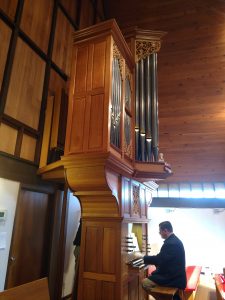
Paul Thornock began the musical demonstration with Johann Gottfried Walther’s Partita on Jesu, meine Freude, followed by a Buxtehude prelude. Audience members helped bring the program to an end by singing a setting of Hyfrydol as Paul improvised an accompaniment.
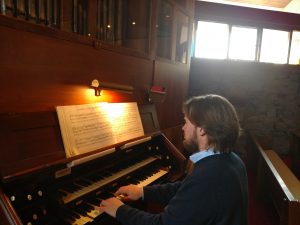
The day’s program, organized by Curt Sather, organist at St. John’s Episcopal Church in Olympia, reconvened at Faith Lutheran Church. The organ at Faith Lutheran, Opus 595 of Henry Pilcher’s Sons, was built in 1907 and delivered to First Baptist Church of Sidney, OH. Failing to recognize their good fortune, the Ohio Baptists sold the organ in 1979 but retained the case to house the electronic device they were purchasing. Thus, in its Shelton home, the organ is housed by a makeshift case of plywood and glass. The organ has two manuals, 13 stops, with a 30-note pedalboard.
Curt began his association with Faith Lutheran when he was asked to figure out why a pipe wasn’t working. He solved that problem by removing the dead bird. The birds apparently learned their lesson, so the organ was in good shape when Curt began his demonstration. Using Bach chorale preludes, he showcased individual stops, groups of stops, and full organ.
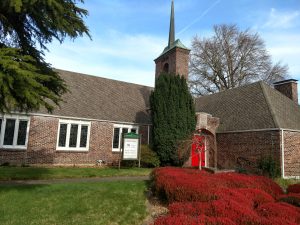
The group moved on to St. David of Wales Episcopal Church, which had prepared lunch. According to the rector, the church was using an “electronic thing” when somebody left money for a new organ–and the gift specified a pipe organ. The organ committee settled on purchasing an existing organ, but the sellers had underestimated its size by 3 feet and it didn’t fit. Contracting for a new organ would be more expensive, but the vestry agreed to it if the organ committee could sell the Rodgers, which they managed to do. The committee approached Paul Fritts, and he agreed to build the organ, but only if the church would remove the acoustical ceiling tile and replace it with spruce–which they did.
With the livelier room on the horizon, Paul set out to design Opus 2A. Opus 2A was one of four organs sharing the same case design but with differences in disposition and voicing. Opus 2B went to the home of David Dahl; 2C went to a former student of David Dahl; and 2D went to Joan Lippincott in Princeton, NJ. All of the Opus 2 siblings featured Dutch pipes, but Paul was beginning to think about casting his own pipes because he ran into continued trouble with the Dutch firm failing to meet his standards. One of the problems was that Paul wanted pipes with a high lead concentration, and the Dutch supplier was unable to produce them because their casting tables could not withstand the high heat required. Instead, the supplier produced pipes with 15% lead that can be cast at a lower temperature. Unfortunately, the 15% lead alloy is structurally weak. Paul revived and honed the more ancient practice of casting pipes on sand tables and has been making his own pipes since Opus 4.
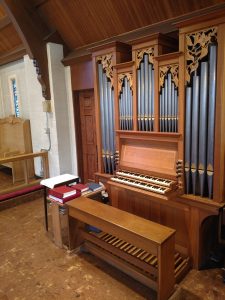
Opus 2A, in St. David’s, is a 2-manual, 8-stop organ, with suspended key action, mechanical stop action, and a flat 30-note pedalboard. Since it was to be placed against a side wall, it had to be voiced in a robust way to fill the church. At that time, most of the voicing was done on site. Paul was still finding his way, and was very cautious, making small changes and then listening to the organ with the room empty as well as during church services. Voicing an organ required prolonged site visits, sometimes sleeping in the church for days at a time. Today, thanks to experience, Paul’s crew is able to do most of the voicing in the shop, having learned what pipes need to do in a particular room. The final voicing, of course, is done on site, but goes much faster thanks to the “pre-voicing.”
Paul laughed when asked if there were things he would have done differently when he looks at his early organs. For example, the regal at St. David’s has a tendency not to stay in tune. Experience has taught Paul how to resolve that problem, and he would like to fix the regal some day. There are other things that, when Paul looks at his early works, he wonders why he stopped doing them.
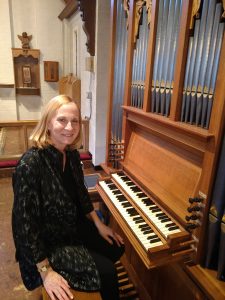
Following Paul’s discussion, a demonstration of the organ was given by April Kuhr, a Shelton resident and member of the Olympia AGO chapter.
Acknowledgments
Many people contributed to the success of this program. Curt Sather, organist at St. John’s Episcopal Church, conceived of this program and organized it. Thanks to Paul Fritts for discussing the organs–and for building two of them! Thanks to Paul Thornock, April Kuhr, and Curt Sather for demonstrating the organs.
Special thanks to our three host churches for graciously opening their doors and making us feel welcome–for cookies and coffee, and lunch, and for contributing to the discussions of their organs.

